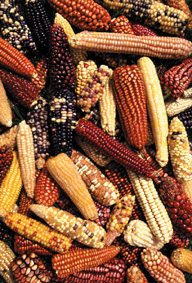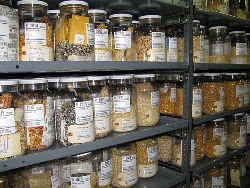Conservation of maize genetic resources
Contributors to this page: CIMMYT, Mexico (Suketoshi Taba, Bonnie J. Furman), with inputs also received from IITA, Nigeria (Dominique Dumet), EMBRAPA (maize and sorghum genebank), Brazil (Flavia Teixeira), USDA(ARS/NC7, ISU), USA (Mark Millard).
Importance of maize conservation
 Conservation of maize means |
The variability amongst maize landraces exceeds the variability in any other crop species. Maize genetic resources constitute an immeasurable treasure for humankind. Their conservation and the investigation of existing variation and possible current and future uses provide:
- Resources for agricultural improvement to reduce hunger and poverty.
- A solid knowledge base for future generations of researchers and technological users.
Maize ex situ germplasm collections include landraces (maize races), improved populations (synthetics and varieties, cycles of selection), inbreds (early generation lines and homozygous lines), reference hybrids and genetic stocks (natural genes and transgenes) and wild species (caryopses and clones).
- Genebanks should have a clear policy on what types of maize germplasm, as well as the extent of the existing diversity (global, regional, and national), should be conserved.
The value of germplasm within genebanks is mostly measured by the extent of utilization of their genetic variation (mostly for breeding programmes). Landraces have the value of adaptation to specific cultivated regions or ecological conditions. Wild species may contain special genes such as those conferring disease resistance, climate adaptation, or nutritional quality.
Commercial maize breeding has exploited only an elite fraction (5-10%) of the more than 300 landraces estimated to exist in the New World (the center of origin and where most of the diversity still exists). Some races of maize have been displaced by modern cultivars while others are threatened as a result of modern farming and ranching practices. While local maize landraces can still be found in areas where Native Americans predominate, economic forces are often eroding the well-being of many small farmers, resulting in a reduction of the land area devoted to most landraces.
 Inside CIMMYT's genebank (photo: CIMMYT) |
 Maize diversity at the USDA genebank (photo: L. Guarino, by kind permission of USDA genebank in Ames, Iowa, USA) |
Germplasm collection and conservation
The first extensive ex situ maize germplasm collection is documented in a booklet resulting from a collecting mission of maize races in Mexico (Wellhausen et al.,1952) and later in additional booklets from collecting missions in Central America, the Caribbean and South America (Goodman and Brown, 1988). The majority of maize germplasm from Latin America is conserved in the ex situ germplasm collections at CIMMYT, the USDA and national genebanks, through coordinated efforts over the last 50-60 years. Similarly, from the 1970s onwards, more international and national efforts to preserve maize germplasm in the Americas and other continents have been conducted. Landraces and enhanced germplasm are the main objective of ex situ conservation by national and international maize genebanks. A recent survey of ex situ collections and their holdings is summarized in the strategy for ex situ conservation and utilization of maize germplasm (Global Crop Diversity Trust, 2007).
Additionally, where in situ maize diversity is being cultivated, ex situ genebanks, such as those of Latin American countries, support and back up in situ maize races in production and evolution in partnership with the local breeding and development institutions and farmers. Ex situ genebank activity is complementary to in situ conservation. The future maize genetic diversity and maize evolution through gene pools that the farmers and the breeders manage, are supported by the conservation activities of ex situ maize genebanks (Taba et al. 2004).
Major maize collections
The total number of unique New World germplasm accessions has been estimated at more than 27,000 (excluding breeding materials). The active collections in Latin America are being conserved in Argentina, Bolivia, Brazil, Colombia, CIMMYT, Cuba, Ecuador, Guatemala, Mexico, Peru, Paraguay and Venezuela. Important individual collections are also being conserved or duplicated in the USA (NCGRP – Ft. Collins; NCRPIS – Ames, Iowa).
The estimated number of accessions in the Old World collections varies between 20 000 and 40 000 (depending on whether breeding materials are included and assuming many could be duplicates). Most of these accessions probably represent descendants of widely-distributed, open pollinated varieties or hybrids from New World accessions after the voyage of Columbus (Brandolini, 1970; Taba, 1997a).
In addition to major germplasm collections, there is also the Maize Genetics Cooperation Stock Center at the University of Illinois (USA), in which various identified genes in maize are preserved in a specific genetic background (Global Crop Diversity Trust, 2007).
References and further reading
Brandolini A. 1970. Maize. In: Frankel OH, Bennett E, editors. Genetic Resources in Plants: Their Exploration and Conservation. F.A. Davis Co., Philadelphia. pp. 273-309.
Chang TT. 1985. Preservation of crop germplasm. Iowa State Journal of Research. Vol. 59. No.4. pp. 365-378.
CIMMYT. 2006. Maize Germplasm Networking Meeting. Global Maize Genetic Resources Conservation: A Workshop on Conservation, Management, and Networking. 2-5 May 2006, CIMMYT, El Batan, Mexico D.F.: CIMMYT.
Ellis RH. 1998. Longevity of seeds stored hermetically at low moisture contents. Seed Science Research supplement 1:9-10.
Ellis RH, Hong TD, Roberts EH. 1985. Handbook of seed technology for genebanks volume I. Principles and Methodology. Handbooks for Genebanks no. 2. International Board for Plant Genetic Resources, Rome.
FAO/IPGRI. 1994. Genebank standards. Food and Agriculture Organization of the United Nations, Rome and International Plant Genetic Resources Institute, Rome. Available in English, Spanish, French and Arabic.
Global Crop Diversity Trust. 2007. Global strategy for the ex situ conservation and utilization of maize germplasm [online]. Available for download from: http://www.croptrust.org/content/maize. Date accessed: 21 March 2013.
Goodman MM, Brown WL. 1988. Races of corn. In: Sprague GF, Dudley JW, editors. Corn and corn improvement, third edition, monograph 18. American Society of Agronomy, Inc., Crop Science Society of America, Inc. and Soil Science Society of America, Inc. pp. 33-79.
Gomez-Campo C. 2006. Erosion of genetic resources within seed genebanks: The role of seed containers. Seed Science Research 16:291-294.
Hanson J. 1985. Procedures for handling seeds in genebanks. Practical manuals for genebanks no. 1. International Board for Plant Genetic Resources, Rome.
Hong TD, Ellis RH. 1996. A protocol to determine seed storage behavior. IPGRI Technical Bulletin No. 1. International Plant Genetic Resources Institute. Rome. Italy. Available here.
IBPGR. 1991. Descriptors for maize. International Maize and Wheat Improvement Center, Mexico City/International Board for Plant Genetic Resources, Rome. Available here.
International Seed Testing Association. 1993. International rules for seed testing. Seed Science and Technology 21, Supplement.
James C. 2007. Global Status of Commercialized Biotech/GM Crops: 2007. ISAAA Brief Vol. 37. ISAAA: Ithaca, NY.
Jaramillo S, Baena M. 2000. Material de apoyo a la capacitación en conservación ex situ de recursos fitogeneticos. Instituto Internacional de Recursos Fitogeneticos, Cali, Colombia.
Justice OL, Bass LN. 1978. Principles and practices of seed storage. Agriculture handbook no. 506. U.S. Government Printing Office, Washington D.C.
Mezzalama M, Gilchrist L, McNab A. 2005. Seed Health: Rules and regulations for the safe movement of germplasm. Mexico. D.F., CIMMYT. Available from: http://libcatalog.cimmyt.org/download/cim/93586.pdf. Date accessed: 3 September 2010.
Pardey PG, Koo B, Wright BD, Van Dusen ME, Skovmand B, Taba S. 2001. Costing the conservation of genetic resources: CIMMYT’s ex situ maize and wheat collection. Crop Science 41(4):1286-1299. Available from : http://sgrp.cgiar.org/sites/default/files/Pardey-2001.pdf. Accessed: 15 September 2010.
Probert RJ, Hay FR. 2000. Keeping seeds alive. In: Black M, Bewley JD, editors. Seed technology and its biological basis. CRC Press LLC. USA and Canada. pp. 375-404.
Taba S, editor. 2005. Latin American Maize Germplasm Conservation: Regeneration, In situ Conservation, Core Collection, and Prebreeding: Proceedings of a Workshop held at CIMMYT. April 7-10, 2003. Mexico, D.F.: CIMMYT.
Taba S. 1997a. Maize. In: Fuccillo D, Sears L, Stapleton P, editors. Biodiversity in Trust, conservation and use of plant genetic resources in CGIAR Centers. Cambridge Univ. Press. pp. 213-226.
Taba S, editor. 1997b. Latin American Maize Germplasm Regeneration and Conservation: Proceedings of a Workshop held at CIMMYT, June 1-6, 1996. Maize Program Special Report. Mexico, D.F.: CIMMYT.
Taba S, Eberhart SA, Pollak LM. 2004. Germplasm resources. In Smith CW, Betran J, Range ECA (eds.) Corn: Origin, History, Technology, and Production. USA: John Wiley & Sons, Inc. Pp.99-132.
Walters C, Wheeler LM, Grotenhuis JM. 2005. Longevity of seeds stored in a genebank: species characteristics. Seed Science Research 15:1-20.
Warham EJ, Butler LD, Sutton BC. 1996. Seed testing of maize and wheat: A laboratory guide. CIMMYT, Mexico and CAB International, UK.
Wellhausen E, Roberts J, Roberts LM, Hernandez E. 1952. Races of Maize in Mexico: Their Origin, Characteristics, and Distribution. Harvard University Press, Cambridge, MA.
Comments
- No comments found



 Conservation
Conservation
Leave your comments
Post comment as a guest